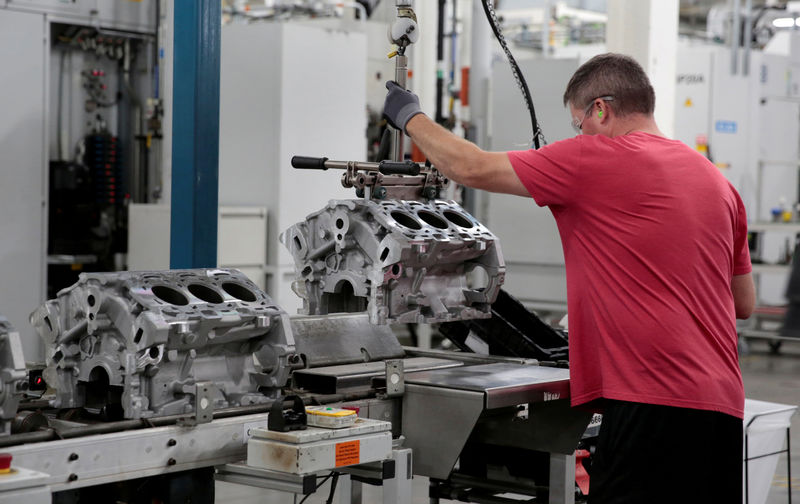By Lucia Mutikani
WASHINGTON (Reuters) - U.S. factory activity contracted for a fourth straight month in November as new orders slumped back to around their lowest level since 2012, while construction spending fell in October, tempering optimism over the economy that had been fanned by a recent run of upbeat reports.
The data on Monday led the Federal Reserve Bank of Atlanta to slash its gross domestic product estimate for the fourth quarter. The Atlanta Fed had only last Wednesday boosted its growth estimate by whopping 1.3% percentage points in the wake of encouraging news, including a sharp drop in the goods trade deficit in October and a strong rebound in a proxy of business spending on equipment.
The Institute for Supply Management (ISM) said its index of national factory activity dropped 0.2 point to a reading of 48.1 last month. A reading below 50 indicates contraction in the manufacturing sector, which accounts for 11% of the U.S. economy. Economists polled by Reuters had forecast the index rising to 49.2 in November from 48.3 in the prior month.
Though the ISM said business sentiment had improved relative to October, likely as the United States and China inched towards a partial trade deal, November's reading marked the fourth straight month that the index remained below the 50 threshold.
The ISM index remains above the 42.9 level, which is associated with a recession in the broader economy. The ISM's forward-looking new orders sub-index tumbled 1.9 points to a reading of 47.2 last month, matching July's reading, which was the lowest since June 2012. A measure of export orders dropped 2.5 points to a reading of 47.9.
"There is nothing to point to in this report that signals a bottom in domestic manufacturing and the decline in new orders if anything suggests downside risk," said Andrew Hollenhorst, an economist at Citigroup (NYSE:C) in New York.
The survey's factory employment index fell 1.1 points to a reading of 46.6 last month. This raises the risk that factory payrolls remained depressed in November after being weighed down by striking workers at General Motors (N:GM) in October.
November's drop in the ISM index is at odds with the so-called hard data, including the surge in October of orders for non-defense capital goods excluding aircraft, that had hinted at some stabilization in manufacturing activity.
A separate survey by IHS Markit showed manufacturing and new orders expanding in November. Still, the sharp contraction in the ISM new orders measure last month poses a high hurdle for any manufacturing recovery. The downturn in manufacturing in the United States bucked trends in the euro zone and China, where factory activity appeared to stabilize in November.
While Washington and Beijing are working towards a partial trade deal, President Donald Trump on Monday said U.S. legislation backing protesters in Hong Kong did not make trade negotiations with China easier. Economists say a complete trade deal is needed to revive manufacturing.
Manufacturing, which is also struggling with a domestic inventory bloat, slowing profit growth and weak overseas demand, was dealt another blow on Monday. Trump restored tariffs on steel and aluminum imports from Brazil and Argentina, accusing them of devaluing their currencies at the expense of U.S. farmers.
POLICY UNCERTAINTY DRAGS
"We expect trade policy uncertainty to continue weighing on manufacturing activity into the new year. Slower external and domestic demand will also constrain manufacturing moving forward," said Oren Klachkin, lead economist at Oxford Economics in New York.
Continued weakness in manufacturing could see Trump sharpening his attacks on the Federal Reserve, which in October cut interest rates for the third time this year and signaled a pause in the easing cycle that started in July when it reduced borrowing costs for the first time since 2008.
Trump wrote on Twitter on Monday "Lower Rates & Loosen - Fed!"
The weak data pushed the dollar to a two-week low against a basket of currencies. The Treasury yield curve steepened, while stocks on Wall Street fell broadly.
The ISM said "global trade remains the most significant cross-industry issue." It said only five industries, including paper and computer and electronic products reported growth last month. Transportation equipment, machinery, and electrical equipment, appliances and components were among the 13 industries reporting a contraction.
Wood products manufacturers complained "profits are elusive," noting that "markets have downshifted further," and that "the continued confusion surrounding China trade has kept export markets on edge." Petroleum and coal products manufacturers said the "slowdown in business has us revising our 2020-21 capital spend."
But manufacturing could get a lift from increased automobile production following the end of the GM strike.
More support could come from Boeing (N:BA) which said recently it hopes to resume deliveries of its fast-selling 737 MAX before the end of the year. Deliveries of the aircraft were suspended after it was grounded in March following fatal crashes in Indonesia and Ethiopia.
But for now, clouds continue to gather over the economy. In a separate report on Monday, the Commerce Department said construction spending dropped 0.8% as investment in private projects tumbled to its lowest level in three years.
Following the dour reports, the Atlanta Fed cut its fourth-quarter GDP growth estimate to a 1.3% annualized rate from a 1.7% pace. The economy grew at a 2.1% rate in the second quarter.
